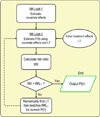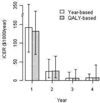Modelling the cost effectiveness of disease-modifying treatments for multiple sclerosis: issues to consider
- PMID: 23640103
- PMCID: PMC3697004
- DOI: 10.1007/s40273-013-0063-4
Modelling the cost effectiveness of disease-modifying treatments for multiple sclerosis: issues to consider
Abstract
Several cost-effectiveness models of disease-modifying treatments (DMTs) for multiple sclerosis (MS) have been developed for different populations and different countries. Vast differences in the approaches and discrepancies in the results give rise to heated discussions and limit the use of these models. Our main objective is to discuss the methodological challenges in modelling the cost effectiveness of treatments for MS. We conducted a review of published models to describe the approaches taken to date, to identify the key parameters that influence the cost effectiveness of DMTs, and to point out major areas of weakness and uncertainty. Thirty-six published models and analyses were identified. The greatest source of uncertainty is the absence of head-to-head randomized clinical trials. Modellers have used various techniques to compensate, including utilizing extension trials. The use of large observational cohorts in recent studies aids in identifying population-based, 'real-world' treatment effects. Major drivers of results include the time horizon modelled and DMT acquisition costs. Model endpoints must target either policy makers (using cost-utility analysis) or clinicians (conducting cost-effectiveness analyses). Lastly, the cost effectiveness of DMTs outside North America and Europe is currently unknown, with the lack of country-specific data as the major limiting factor. We suggest that limited data should not preclude analyses, as models may be built and updated in the future as data become available. Disclosure of modelling methods and assumptions could improve the transferability and applicability of models designed to reflect different healthcare systems.
Figures



Similar articles
-
Modeling Approaches in Cost-Effectiveness Analysis of Disease-Modifying Therapies for Relapsing-Remitting Multiple Sclerosis: An Updated Systematic Review and Recommendations for Future Economic Evaluations.Pharmacoeconomics. 2018 Oct;36(10):1223-1252. doi: 10.1007/s40273-018-0683-9. Pharmacoeconomics. 2018. PMID: 29971666
-
Cost-effectiveness analyses in multiple sclerosis: a review of modelling approaches.Pharmacoeconomics. 2014 Jun;32(6):559-72. doi: 10.1007/s40273-014-0150-1. Pharmacoeconomics. 2014. PMID: 24643323 Review.
-
Squinting through layers of fog: assessing the cost effectiveness of treatments for multiple sclerosis.Appl Health Econ Health Policy. 2013 Aug;11(4):331-41. doi: 10.1007/s40258-013-0034-0. Appl Health Econ Health Policy. 2013. PMID: 23637055 Review.
-
The future of Cochrane Neonatal.Early Hum Dev. 2020 Nov;150:105191. doi: 10.1016/j.earlhumdev.2020.105191. Epub 2020 Sep 12. Early Hum Dev. 2020. PMID: 33036834
-
Economics and Cost-Effectiveness of Multiple Sclerosis Therapies in the USA.Neurotherapeutics. 2017 Oct;14(4):1018-1026. doi: 10.1007/s13311-017-0566-3. Neurotherapeutics. 2017. PMID: 28812229 Free PMC article. Review.
Cited by
-
Modeling Approaches in Cost-Effectiveness Analysis of Disease-Modifying Therapies for Relapsing-Remitting Multiple Sclerosis: An Updated Systematic Review and Recommendations for Future Economic Evaluations.Pharmacoeconomics. 2018 Oct;36(10):1223-1252. doi: 10.1007/s40273-018-0683-9. Pharmacoeconomics. 2018. PMID: 29971666
-
Overexpression of the recombinant human interferon-beta (rhIFN-β) gene in tobacco chloroplasts.BioTechnologia (Pozn). 2021 Dec 22;102(4):367-376. doi: 10.5114/bta.2021.111094. eCollection 2021. BioTechnologia (Pozn). 2021. PMID: 36605601 Free PMC article.
-
How have Economic Evaluations in Relapsing Multiple Sclerosis Evolved Over Time? A Systematic Literature Review.Neurol Ther. 2021 Dec;10(2):557-583. doi: 10.1007/s40120-021-00264-1. Epub 2021 Jul 19. Neurol Ther. 2021. PMID: 34279847 Free PMC article. Review.
-
New insights into the burden and costs of multiple sclerosis in Europe.Mult Scler. 2017 Jul;23(8):1123-1136. doi: 10.1177/1352458517694432. Epub 2017 Feb 1. Mult Scler. 2017. PMID: 28273775 Free PMC article.
-
A Multiple Treatment Comparison of Eleven Disease-Modifying Drugs Used for Multiple Sclerosis.J Clin Med Res. 2018 Feb;10(2):88-105. doi: 10.14740/jocmr3168w. Epub 2017 Dec 30. J Clin Med Res. 2018. PMID: 29317954 Free PMC article.
References
-
- Jacobs LD, Cookfair DL, Rudick RA, et al. Intramuscular interferon beta-1a for disease progression in relapsing multiple sclerosis. The Multiple Sclerosis Collaborative Research Group (MSCRG) Annals of Neurology. 1996;39(3):285–294. - PubMed
-
- PRISMS Study Group. Randomised double-blind placebo-controlled study of interferon beta-1a in relapsing/remitting multiple sclerosis. PRISMS (Prevention of Relapses and Disability by Interferon beta-1a Subcutaneously in Multiple Sclerosis) Study Group. Lancet. 1998;352(9139):1498–1504. - PubMed
-
- Rudick RA, Goodkin DE, Jacobs LD, et al. Impact of interferon beta-1a on neurologic disability in relapsing multiple sclerosis. The Multiple Sclerosis Collaborative Research Group (MSCRG) Neurology. 1997;49(2):358–363. - PubMed
-
- The IFNB Multiple Sclerosis Study Group. Interferon beta-1b delays progression of disability in secondary progressive multiple sclerosis: results of a European multicenter randomised study. Lancet. 1998;352:1491–1497. - PubMed
-
- IFNB Multiple Sclerosis Study Group. Interferon beta-lb is effective in relapsing-remitting multiple sclerosis. I. Clinical results of a multicenter, randomized, double-blind, placebo-controlled trial. Neurology. 1993;43:655–661. - PubMed
Publication types
MeSH terms
Substances
Grants and funding
LinkOut - more resources
Full Text Sources
Other Literature Sources
Medical

